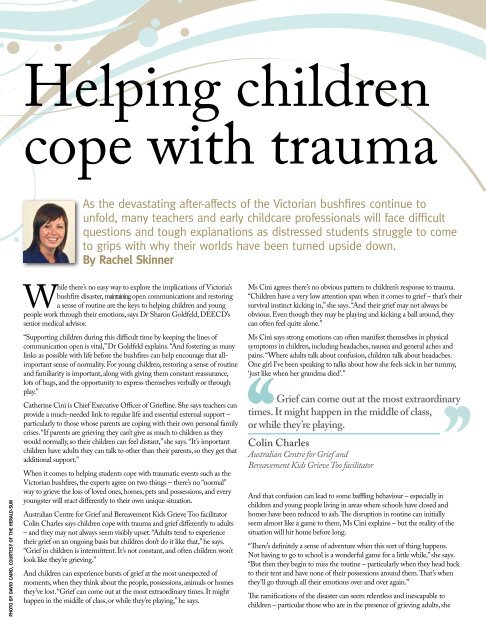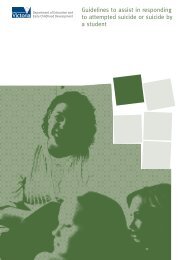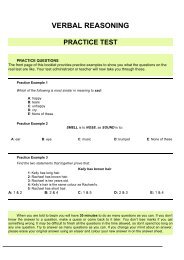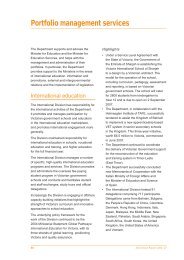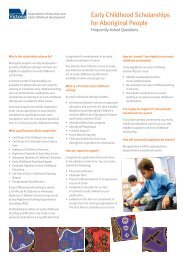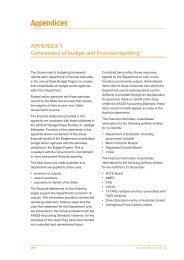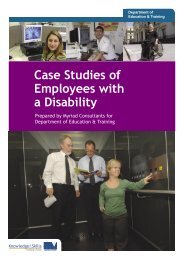Shine, March 2009, Vol. 02 - Department of Education and Early ...
Shine, March 2009, Vol. 02 - Department of Education and Early ...
Shine, March 2009, Vol. 02 - Department of Education and Early ...
You also want an ePaper? Increase the reach of your titles
YUMPU automatically turns print PDFs into web optimized ePapers that Google loves.
Helping children<br />
cope with trauma<br />
As the devastating after-affects <strong>of</strong> the Victorian bushfires continue to<br />
unfold, many teachers <strong>and</strong> early childcare pr<strong>of</strong>essionals will face difficult<br />
questions <strong>and</strong> tough explanations as distressed students struggle to come<br />
to grips with why their worlds have been turned upside down.<br />
By Rachel Skinner<br />
PHOTO BY DAVID CAIRD, COURTESY OF THE HERALD-SUN<br />
While there’s no easy way to explore the implications <strong>of</strong> Victoria’s<br />
bushfire disaster, maintaining open communications <strong>and</strong> restoring<br />
a sense <strong>of</strong> routine are the keys to helping children <strong>and</strong> young<br />
people work through their emotions, says Dr Sharon Goldfeld, DEECD’s<br />
senior medical advisor.<br />
“Supporting children during this difficult time by keeping the lines <strong>of</strong><br />
communication open is vital,” Dr Goldfeld explains. “And fostering as many<br />
links as possible with life before the bushfires can help encourage that allimportant<br />
sense <strong>of</strong> normality. For young children, restoring a sense <strong>of</strong> routine<br />
<strong>and</strong> familiarity is important, along with giving them constant reassurance,<br />
lots <strong>of</strong> hugs, <strong>and</strong> the opportunity to express themselves verbally or through<br />
play.”<br />
Catherine Cini is Chief Executive Officer <strong>of</strong> Griefline. She says teachers can<br />
provide a much-needed link to regular life <strong>and</strong> essential external support –<br />
particularly to those whose parents are coping with their own personal family<br />
crises. “If parents are grieving they can’t give as much to children as they<br />
would normally, so their children can feel distant,” she says. “It’s important<br />
children have adults they can talk to other than their parents, so they get that<br />
additional support.”<br />
When it comes to helping students cope with traumatic events such as the<br />
Victorian bushfires, the experts agree on two things – there’s no “normal”<br />
way to grieve the loss <strong>of</strong> loved ones, homes, pets <strong>and</strong> possessions, <strong>and</strong> every<br />
youngster will react differently to their own unique situation.<br />
Australian Centre for Grief <strong>and</strong> Bereavement Kids Grieve Too facilitator<br />
Colin Charles says children cope with trauma <strong>and</strong> grief differently to adults<br />
– <strong>and</strong> they may not always seem visibly upset. “Adults tend to experience<br />
their grief on an ongoing basis but children don’t do it like that,” he says.<br />
“Grief in children is intermittent. It’s not constant, <strong>and</strong> <strong>of</strong>ten children won’t<br />
look like they’re grieving.”<br />
And children can experience bursts <strong>of</strong> grief at the most unexpected <strong>of</strong><br />
moments, when they think about the people, possessions, animals or homes<br />
they’ve lost. “Grief can come out at the most extraordinary times. It might<br />
happen in the middle <strong>of</strong> class, or while they’re playing,” he says.<br />
Ms Cini agrees there’s no obvious pattern to children’s response to trauma.<br />
“Children have a very low attention span when it comes to grief – that’s their<br />
survival instinct kicking in,” she says. “And their grief may not always be<br />
obvious. Even though they may be playing <strong>and</strong> kicking a ball around, they<br />
can <strong>of</strong>ten feel quite alone.”<br />
Ms Cini says strong emotions can <strong>of</strong>ten manifest themselves in physical<br />
symptoms in children, including headaches, nausea <strong>and</strong> general aches <strong>and</strong><br />
pains. “Where adults talk about confusion, children talk about headaches.<br />
One girl I’ve been speaking to talks about how she feels sick in her tummy,<br />
‘just like when her gr<strong>and</strong>ma died’.”<br />
Grief can come out at the most extraordinary<br />
times. It might happen in the middle <strong>of</strong> class,<br />
or while they’re playing.<br />
Colin Charles<br />
Australian Centre for Grief <strong>and</strong><br />
Bereavement Kids Grieve Too facilitator<br />
And that confusion can lead to some baffling behaviour – especially in<br />
children <strong>and</strong> young people living in areas where schools have closed <strong>and</strong><br />
homes have been reduced to ash. The disruption in routine can initially<br />
seem almost like a game to them, Ms Cini explains – but the reality <strong>of</strong> the<br />
situation will hit home before long.<br />
“There’s definitely a sense <strong>of</strong> adventure when this sort <strong>of</strong> thing happens.<br />
Not having to go to school is a wonderful game for a little while,” she says.<br />
“But then they begin to miss the routine – particularly when they head back<br />
to their tent <strong>and</strong> have none <strong>of</strong> their possessions around them. That’s when<br />
they’ll go through all their emotions over <strong>and</strong> over again.”<br />
The ramifications <strong>of</strong> the disaster can seem relentless <strong>and</strong> inescapable to<br />
children – particular those who are in the presence <strong>of</strong> grieving adults, she


